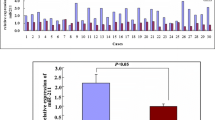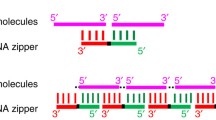Abstract
MicroRNAs are small, non-coding RNAs that inhibit gene expression posttranscriptionally through interaction with the 3′ untranslated region (3′ UTR) of target mRNAs. The most important factor for downregulation of target genes by miRNA is the “seed region,” which encompasses nucleotides 2–7 at the 5′ end of the miRNA. In this study, sequence determinants for efficient downregulation of target genes were investigated by employing growth-suppressive miR-608 and miR-4651, which shares the seed sequence with miR-608. Cell growth experiments revealed that miR-4651 and miR-608-scram in which the seed sequences were mutated did not inhibit the growth of A549 cells in contrast to wild-type miR-608, which significantly inhibited cell growth. When similarity to miR-608 was increased by replacing sequences of miR-4651 with that of miR-608, cell growth was gradually more inhibited. Similar results were obtained from a luciferase reporter assay using a reporter plasmid containing the 3′ UTR of BCL2L1 and from western blot analysis of BCL2L1, CCND3, and phosphoinositide 3-kinase regulatory subunit 2. Moreover, microarray analyses revealed that overexpression of miR-4651 and miR-608-scram resulted in inefficient downregulation of target genes, and the number of downregulated genes was increased when transfected with MT-3 mimic, which differs from miR-608 by four nucleotides located in the central region. Together, our findings provide a basis for understanding the mechanism underlying target recognition and/or downregulation of target genes by miR-608 and indicate that in addition to seed sequence, central and 3′ parts of miR-608 play an important role in mediating efficient downregulation of target genes.



Similar content being viewed by others
References
Baek D, Villén J, Shin C, Camargo FD, Gygi SP, Bartel DP (2008) The impact of microRNAs on protein output. Nature 455:64–71
Bartel DP (2004) MicroRNAs: genomics, biogenesis, mechanism, and function. Cell 116:281–297
Bartel DP (2009) MicroRNAs: target recognition and regulatory functions. Cell 136:215–233
Brennecke J, Stark A, Russell RB, Cohen SM (2005) Principles of microRNA–target recognition. PLoS Biol 3:e85
Choi YC, Yoon S, Byun Y, Lee G, Kee H, Jeong Y, Yoon J, Baek K (2015) MicroRNA library screening identifies growth-suppressive microRNAs that regulate genes involved in cell cycle progression and apoptosis. Exp Cell Res 339:320–332
Didiano D, Hobert O (2006) Perfect seed pairing is not a generally reliable predictor for miRNA–target interactions. Nat Struct Mol Biol 13:849–851
Duursma AM, Kedde M, Schrier M, le Sage C, Agami R (2008) miR-148 targets human DNMT3b protein coding region. RNA 14:872–877
Ebner OA, Selbach M (2014) Quantitative proteomic analysis of gene regulation by miR-34a and miR-34c. PLoS One 9:e92166
Grey F, Tirabassi R, Meyers H, Wu G, McWeeney S, Hook L, Nelson JA (2010) A viral microRNA down-regulates multiple cell cycle genes through mRNA 5′UTRs. PLoS Pathog 6:e1000967
Grimson A, Farh KK, Johnston WK, Garrett-Engele P, Lim LP, Bartel DP (2007) MicroRNA targeting specificity in mammals: determinants beyond seed pairing. Mol Cell 27:91–105
Guo H, Ingolia NT, Weissman JS, Bartel DP (2010) Mammalian microRNAs predominantly act to decrease target mRNA levels. Nature 466:835–840
He L, Hannon GJ (2004) MicroRNAs with a big role in gene regulation. Nat Rev Genet 5:522–531
Kertesz M, Iovino N, Unnerstall U, Gaul U, Segal E (2007) The role of site accessibility in microRNA target recognition. Nat Genet 39:1278–1284
Kim S, Lee UJ, Kim MN, Lee EJ, Kim JY, Lee MY, Choung S, Kim YJ, Choi YC (2008) MicroRNA miR-199a* regulates the MET proto-oncogene and the downstream extracellular signal-regulated kinase 2 (ERK2). J Biol Chem 283:18158–18166
Lewis BP, Shih IH, Jones-Rhoades MW, Bartel DP, Burge CB (2003) Prediction of mammalian microRNA targets. Cell 115:787–798
Lewis BP, Burge CB, Bartel DP (2005) Conserved seed pairing, often flanked by adenosines, indicates that thousands of human genes are microRNA targets. Cell 120:15–20
Lim LP, Lau NC, Garrett-Engele P, Grimson A, Schelter JM, Castle J, Bartel DP, Linsley PS, Johnson JM (2005) Microarray analysis shows that some microRNAs downregulate large numbers of target mRNAs. Nature 433:769–773
Linsley PS, Schelter J, Burchard J, Kibukawa M, Martin MM, Bartz SR, Johnson JM, Cummins JM, Raymond CK, Dai H, Chau N, Cleary M, Jackson AL, Carleton M, Lim L (2007) Transcripts targeted by the microRNA-16 family cooperatively regulate cell cycle progression. Mol Cell Biol 27:2240–2252
Moore MJ, Scheel TK, Luna JM, Park CY, Fak JJ, Nishiuchi E, Rice CM, Darnell RB (2015) miRNA–target chimeras reveal miRNA 3′-end pairing as a major determinant of Argonaute target specificity. Nat Commun 6:8864
Nawrocki EP, Burge SW, Bateman A, Daub J, Eberhardt RY, Eddy SR, Floden EW, Gardner PP, Jones TA, Tate J, Finn RD (2015) Rfam 12.0: updates to the RNA families database. Nucleic Acids Res 43:D130–D137
Pasquinelli AE, Reinhart BJ, Slack F, Martindale MQ, Kuroda MI, Maller B, Hayward DC, Ball EE, Degnan B, Müller P, Spring J, Srinivasan A, Fishman M, Finnerty J, Corbo J, Levine M, Leahy P, Davidson E, Ruvkun G (2000) Conservation of the sequence and temporal expression of let-7 heterochronic regulatory RNA. Nature 408:86–89
Reczko M, Maragkakis M, Alexiou P, Grosse I, Hatzigeorgiou AG (2012) Functional microRNA targets in protein coding sequences. Bioinformatics 28:771–776
Selbach M, Schwanhäusser B, Thierfelder N, Fang Z, Khanin R, Rajewsky N (2008) Widespread changes in protein synthesis induced by microRNAs. Nature 455:58–63
Tay Y, Zhang J, Thomson AM, Lim B, Rigoutsos I (2008) MicroRNAs to Nanog, Oct4 and Sox2 coding regions modulate embryonic stem cell differentiation. Nature 455:1124–1128
Xu W, Wang Z, Liu Y (2014) The characterization of microRNA-mediated gene regulation as impacted by both target site location and seed match type. PLoS One 9:e108260
Zhou H, Rigoutsos I (2014) MiR-103a-3p targets the 5′ UTR of GPRC5A in pancreatic cells. RNA 20:1431–1439
Acknowledgments
This work was supported by the Basic Science Research Program through the National Research Foundation of Korea (NRF), funded by the Ministry of Education, Science and Technology [2011-0007189].
Author information
Authors and Affiliations
Corresponding author
Ethics declarations
Conflict of Interest
The authors declare that they have no conflicts of interest.
Ethical guidelines
The present study was conducted in accordance with the ethical guidelines of Kyung Hee University.
Additional information
Gangtae Lee and Young-Chul Choi have contributed equally to this work.
Rights and permissions
About this article
Cite this article
Lee, G., Choi, YC., Byun, Y. et al. The seed sequence is necessary but insufficient for downregulation of target genes by miR-608. Genes Genom 38, 567–572 (2016). https://doi.org/10.1007/s13258-016-0409-3
Received:
Accepted:
Published:
Issue Date:
DOI: https://doi.org/10.1007/s13258-016-0409-3




